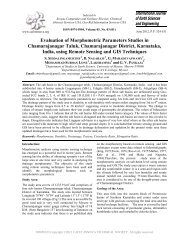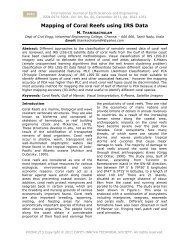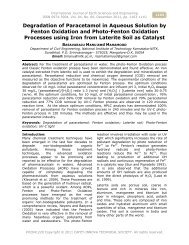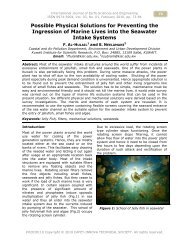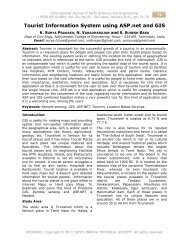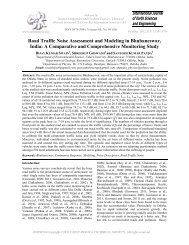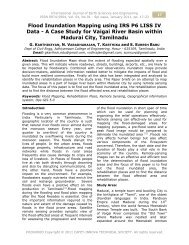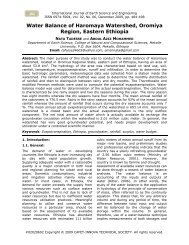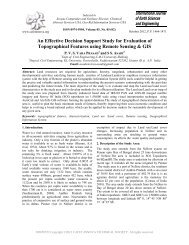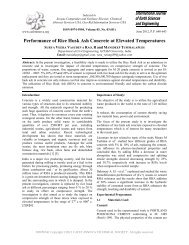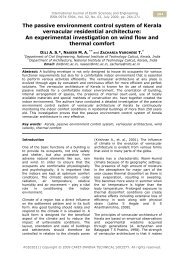Mapping of Water and Soil Quality Parameters for ... - Cafet Innova
Mapping of Water and Soil Quality Parameters for ... - Cafet Innova
Mapping of Water and Soil Quality Parameters for ... - Cafet Innova
Create successful ePaper yourself
Turn your PDF publications into a flip-book with our unique Google optimized e-Paper software.
398International Journal <strong>of</strong> Earth Sciences <strong>and</strong> EngineeringISSN 0974-5904, Vol. 03, No. 03, June 2010, pp. 398-408<strong>Mapping</strong> <strong>of</strong> <strong>Water</strong> <strong>and</strong> <strong>Soil</strong> <strong>Quality</strong> <strong>Parameters</strong> <strong>for</strong>Irrigation Using Remote Sensing <strong>and</strong> GISK. R. SURESH 1 , M. A. NAGESH 2 <strong>and</strong> ABHIRAM SHANKAR 11 Department <strong>of</strong> Civil Engineering, BMS College <strong>of</strong> Engineering, Bengaluru-5600192 Department <strong>of</strong> Civil Engineering, SSIT, Tumkur-572105Email: suriiisc@yahoo.com, manageshssit@yahoo.co.inAbstract: The yield <strong>of</strong> a crop depends on soil properties, the quantity & quality <strong>of</strong> waterapplied, climatic factors <strong>and</strong> farm practices followed during the crop period. <strong>Soil</strong>-waterchemistry plays a very important role in crop growth. With the increasing pressure <strong>of</strong>human population, there is a severe stress on water resources. The available surface waterresources are limited <strong>and</strong> being depleted day by day. Many human activities <strong>and</strong> their byproductshave the potential to pollute surface <strong>and</strong> subsurface water. Pollutants enter surfaceor groundwater directly. The yield <strong>of</strong> a crop depends on quality <strong>of</strong> water embraces itscombined physical, chemical <strong>and</strong> biological characteristics. The quality <strong>of</strong> water <strong>for</strong> irrigationis as important as nature <strong>of</strong> soil. It affects the fertility <strong>of</strong> the soil <strong>and</strong> ultimately the cropyield. In this study, an attempt is being made to study the status <strong>of</strong> water quality (surface<strong>and</strong> ground) <strong>and</strong> soil quality at selected stretches <strong>of</strong> Vrishabavathi stream near Bangalore.The study shows that Vrishabavathi river, once used to be the major source <strong>of</strong> water, is fullycontaminated from household, commercial <strong>and</strong> industrial wastes. Most <strong>of</strong> the farmers in thecomm<strong>and</strong> use this contaminated water <strong>for</strong> growing different types <strong>of</strong> crops. Analysis <strong>of</strong> thewater samples show that the water is unsuitable <strong>for</strong> irrigation <strong>and</strong> also affecting the groundwater quality <strong>of</strong> nearby areas along the stream (Comparing with the FAO <strong>and</strong> Central <strong>Water</strong>pollution Control Board guidelines). The results show that the polluted water affects the soilparameters too. The results <strong>of</strong> soil <strong>and</strong> water samples are integrated with GIS which providereal time spatial in<strong>for</strong>mation to the decision makers <strong>and</strong> end users.Keywords: Irrigation, pH, Sodium Adsorption Ratio (SAR), Electrical Conductivity, RemoteSensing & GIS.Introduction:<strong>Water</strong> is a vital natural resource which <strong>for</strong>msthe basis <strong>of</strong> all life. Agriculture is the world’sbiggest water user. It has been known <strong>for</strong>years that the quality <strong>of</strong> irrigation waterdirectly influences the quality <strong>of</strong> the soil <strong>and</strong>the crops grown on the soil. In the lastcentury, the dem<strong>and</strong> <strong>for</strong> agricultural l<strong>and</strong><strong>and</strong> products has grown rapidly as afunction <strong>of</strong> population growth. In addition,experts from all disciplines have agreed thatfactors such as urbanization,industrialization, poor l<strong>and</strong> management <strong>and</strong>environmental pollution imposed additionalstress on agricultural production. All <strong>of</strong> thesefactors have quickly become responsible <strong>for</strong>the decrease in the amount <strong>of</strong> l<strong>and</strong> available<strong>for</strong> agriculture <strong>and</strong> <strong>for</strong> the reduction in thequantity <strong>and</strong> the quality <strong>of</strong> water to irrigatethese l<strong>and</strong>s. A dramatic example <strong>for</strong> thissoil–water quality interaction phenomenon isthe salinity problem that is widelyexperienced in many parts <strong>of</strong> the worldwhere about 10 million hectares <strong>of</strong>agricultural l<strong>and</strong> is lost annually (Tanji,1990, Kwiatkowski, Marciak, Wentz, & King,1995). As a consequence, effective use <strong>of</strong>both the agricultural l<strong>and</strong> <strong>and</strong> the irrigationwater has become an indispensablecomponent <strong>of</strong> many agriculturaldevelopment <strong>and</strong> management plans. In thelast century, another detrimentalconsequence <strong>of</strong> the above mentioned stressfactors have been experienced in thequantity <strong>and</strong> quality <strong>of</strong> surface waters.Invaluable surface water resources haveeither been over consumed to their capacity<strong>and</strong>/or been polluted to such levels that theycould no longer be used not only in directhuman consumption but also in agriculturalirrigation. In many parts <strong>of</strong> the world, thissituation has lead people depend more on#02030510 Copyright © 2010 CAFET-INNOVA TECHNICAL SOCIETY. All rights reserved.
K. R. SURESH, M. A. NAGESH <strong>and</strong> ABHIRAM SHANKAR399groundwater resources <strong>and</strong> has inevitablyresulted in increased dem<strong>and</strong>s on thequantity <strong>and</strong> quality <strong>of</strong> groundwater. It hasnow become clear that this extra burden ongroundwater had its own costs such as rapiddecline in economically consumablegroundwater levels, salt water intrusion incoastal aquifers <strong>and</strong> infiltration <strong>of</strong> pollutedsurface waters into groundwater. Theutilization <strong>of</strong> degraded quality waters inirrigation has been the main cause <strong>for</strong> thedeterioration <strong>of</strong> the quality <strong>of</strong> soils <strong>and</strong> theagricultural crops grown on such soils(Wilcox, 1948; Ayers, 1977; Ayers <strong>and</strong>Westcot, 1985). This degradation has mainlybeen attributed to the accumulation <strong>of</strong>various ions in the soil mass as a result <strong>of</strong>the presence <strong>of</strong> such ions in irrigationwaters in high concentrations. While some<strong>of</strong> these ions <strong>and</strong> elements naturallyappeared in water (i.e., due to interactionswith geological <strong>for</strong>mations), many originatedfrom major anthropological activities.Regardless <strong>of</strong> the cause, the increase in theconcentrations <strong>of</strong> such ions degraded thequality <strong>of</strong> irrigation waters <strong>and</strong> created vitalproblems in agricultural production. Basedon this current situation, water qualitymanagement has become an important toolto guarantee the required amount <strong>of</strong>agricultural production <strong>for</strong> current needs <strong>and</strong>to maintain the sustainability <strong>of</strong> the l<strong>and</strong> <strong>for</strong>future generations. Motivated by thisnecessity, decision makers have asked theexperts to provide non-technical tools tohelp them come up with better decisions.The Index techniques <strong>and</strong> water qualitymapping have been developed as a result <strong>of</strong>this need (Celalettin Simsek & OrhanGunduz, 2007). The irrigation water qualityis mainly assessed as a function <strong>of</strong> the level<strong>of</strong> certain quality parameters. Theseparameters are generally associated with aparticular irrigation problem or some specifichazard that their presence are likely tocreate. In general, the quality <strong>of</strong> anirrigation water resource is associated withits (a) salinity hazard, (b) infiltration orpermeability hazard, (c) specific ion toxicity,(d) trace element toxicity; <strong>and</strong>, (e) variousmiscellaneous effects to susceptible crops.However, it is important to note that thesehazards or negative impacts couldsometimes occur simultaneously, thusmaking their relative significance moredifficult to assess. Furthermore, spatialdistributions <strong>of</strong> other factors such as soiltype <strong>and</strong> crop pattern bring in additionalcomplexity to the problem. There<strong>for</strong>e, it isclear that all <strong>of</strong> these parameters must beinvolved in some way to better assessment<strong>of</strong> irrigation water quality. Based on thismotivation, a GIS-based water <strong>and</strong> soilquality map is developed in this study withparticular emphasis on the spatial variations<strong>of</strong> all related physicochemical qualityparameters. The study area considered hereis the Vrishabavathi comm<strong>and</strong> area locatedon southern side <strong>of</strong> Bangalore, Karnataka,India. Accordingly, a database is created <strong>for</strong>the study area by collecting 122 watersamples (surface & ground water) <strong>and</strong> soilsamples from the study area. The GISintegrateddatabase is then used to createinput data layers <strong>for</strong> the salinity hazard, theinfiltration <strong>and</strong> permeability hazard, thespecific ion toxicity, the trace elementtoxicity <strong>and</strong> the miscellaneous effects to thecrops. The results <strong>of</strong> this case study areused to underst<strong>and</strong> the current status <strong>of</strong>surface <strong>and</strong> groundwater quality in area.Irrigation <strong>Water</strong> <strong>Quality</strong>:The quality <strong>of</strong> irrigation water is highlyvariable depending upon both the type <strong>and</strong>the quantity <strong>of</strong> the salts dissolved in it.These salts originate from natural (i.e.,weathering <strong>of</strong> rocks <strong>and</strong> soil) <strong>and</strong>anthropological (i.e., domestic <strong>and</strong> industrialdischarges) sources <strong>and</strong> once introduced,they follow the flow path <strong>of</strong> the water. Theirrigated soils <strong>and</strong> the crops grown on suchsoils absorb more salts <strong>and</strong> minerals as aresult <strong>of</strong> evaporation <strong>and</strong> crop consumption.Generally, the problems associated with thesoil’s salt content increase as the total saltcontent <strong>of</strong> the irrigation water increases.There<strong>for</strong>e, the irrigation water quality shouldbe considered as an important tool in thesustainable management <strong>of</strong> the soilresources <strong>and</strong> the agricultural production(Wilcox, 1955). It is commonly acceptedthat the problems originating from irrigationwater quality vary in type <strong>and</strong> severity as afunction <strong>of</strong> numerous factors including thetype <strong>of</strong> the soil <strong>and</strong> the crop, the climate <strong>of</strong>International Journal <strong>of</strong> Earth Sciences <strong>and</strong> EngineeringISSN 0974-5904, Vol. 03, No. 03, June 2010, pp. 398-408
400<strong>Mapping</strong> <strong>of</strong> <strong>Water</strong> <strong>and</strong> <strong>Soil</strong> <strong>Quality</strong> <strong>Parameters</strong> <strong>for</strong> Irrigation UsingRemote Sensing <strong>and</strong> GISthe area as well as the farmer.Nevertheless, there is now a commonunderst<strong>and</strong>ing that these problems can becategorized into the following major groups:(a) salinity hazard, (b) infiltration <strong>and</strong>permeability problems, (c) toxicity hazards;<strong>and</strong>, (d) miscellaneous problems (Ayers &Westcot, 1985). The toxicity hazards canfurther be grouped into problems associatedwith specific ions as well as hazards relatedto the presence <strong>of</strong> trace elements <strong>and</strong> heavymetals.Salinity Hazard:Salinity hazard occurs when salts start toaccumulate in the crop root zone reducingthe amount <strong>of</strong> water available to the roots.This reduced water availability sometimesreaches to such level that the crop yield isadversely affected. These salts <strong>of</strong>tenoriginate from dissolved minerals in theapplied irrigation water. The reductions incrop yield occur when the salt content <strong>of</strong> theroot zone reaches to the extent that thecrop is no longer able to extract sufficientwater from the salty soil. When this waterstress is prolonged, plant slows its growth<strong>and</strong> drought-like symptoms start to develop(Ayers & Westcot, 1985). The extent <strong>of</strong>salinity hazard could be measured by theability <strong>of</strong> water to conduct an electriccurrent. Since conductance is a strongfunction <strong>of</strong> the total dissolved ionic solids,either an electrical conductivity (EC)measurement or a total dissolved solids(TDS) analysis could be used in measuringthe salinity <strong>of</strong> water. TDS is a directmeasure <strong>of</strong> dissolved solids <strong>and</strong> EC is anindirect measure <strong>of</strong> ions by an electrode.Generally, the amount <strong>of</strong> water available tothe crop gets lower when the electricalconductivity is higher. Under suchcircumstances, the soil appears to be wetbut the crop experiences the so-calledphysiological drought. As plants can onlytranspire ‘pure’ water, the usable portion <strong>of</strong>water by plants decreases drastically asconductivity increases. Usually, waters withEC values <strong>of</strong> below 700 µS/cm areconsidered to be good quality irrigationwaters. The classification <strong>of</strong> irrigation waterquality based upon its EC value is presentedin Table I.Permeability <strong>and</strong> Infiltration Hazard:Although the infiltration rate <strong>of</strong> water intosoil is a function <strong>of</strong> many parametersincluding the quality <strong>of</strong> the irrigation water<strong>and</strong> the soil factors such as structure,compaction <strong>and</strong> the organic content, thepermeability <strong>and</strong> infiltration hazard typicallyoccurs when high sodium ions decrease therate at which irrigation water enters thesoil’s lower layers. The reduced infiltrationrate starts to show negative impacts whenwater cannot infiltrate to the roots <strong>of</strong> thecrop to the extent that the crop requires.Hence, these salts start to accumulate at thesoil surface. When the crop is not able toextract the required amount <strong>of</strong> water fromthe soil, it is not possible to maintain <strong>and</strong>esired yield <strong>and</strong> the agricultural productionis reduced. The two most common waterquality factors that influence the normal rate<strong>of</strong> infiltration <strong>of</strong> water are the salinity <strong>of</strong>water <strong>and</strong> the relative concentrations <strong>of</strong>sodium, magnesium <strong>and</strong> calcium ions inwater that is also known as the sodiumadsorption ratio (SAR). The SAR value <strong>of</strong>irrigation water quantifies the relativeproportions <strong>of</strong> sodium (Na+) to calcium(Ca++) <strong>and</strong> magnesium (Mg++) <strong>and</strong> iscomputed as: SAR = [Na + ]/ √[Ca +++Mg ++ ]/2, where [Na + ], [Ca ++ ] <strong>and</strong> [Mg ++ ]are defined as the concentrations <strong>of</strong> sodium,calcium <strong>and</strong> magnesium ions in waterrespectively (Ayers & Westcot, 1985). Inthis equation, the concentrations areexpressed as milli equivalents per liter <strong>and</strong>are computed by dividing the aqueousconcentration <strong>of</strong> the corresponding ionexpressed in milligrams per liter by theproduct <strong>of</strong> its atomic weight <strong>and</strong> ioniccharge. As both salinity <strong>and</strong> SAR operate atthe same time, the levels <strong>of</strong> sodium ions inwater are the determining parameters <strong>for</strong>potential infiltration hazards. It is alsoimportant to note that the these hazardstypically occur in the first few centimeters <strong>of</strong>the top soil <strong>and</strong> is strongly linked to thestructural stability <strong>of</strong> the surface soil <strong>and</strong> itslow calcium content relative to that <strong>of</strong>sodium (Ayers & Westcot, 1985). It hasbeen found that when a soil is irrigated withwaters <strong>of</strong> high sodium concentrations, ahigh sodium surface is reported to developInternational Journal <strong>of</strong> Earth Sciences <strong>and</strong> EngineeringISSN 0974-5904, Vol. 03, No. 03, June 2010, pp. 398-408
K. R. SURESH, M. A. NAGESH <strong>and</strong> ABHIRAM SHANKAR401which in turn weakens the soil structure.The soil aggregates <strong>and</strong> then disperses tosmaller particles <strong>and</strong> clogs its pores.Another important parameter is the soil’sclay content. The high SAR values have anegative impact on soil structure due to thedispersion <strong>of</strong> clay particles. The classification<strong>of</strong> irrigation water quality based upon itsinfiltration hazard is presented in Table I.Specific Ion Toxicity:Certain ions such as sodium, chloride <strong>and</strong>boron cause toxicity problems <strong>for</strong> plantswhen they are found in HIGH concentrationsin water or in soil. When these ions aretaken up by the plant <strong>and</strong> accumulate toconcentrations high enough to cause cropdamage or yield reduction, they areconsidered to be toxic. The level <strong>of</strong> toxicityis specific to plant type <strong>and</strong> extraction rate.The permanent, perennial type crops aremore sensitive to this type <strong>of</strong> toxicity whencompared to the annual crops. It is alsoknown that ion toxicity is usuallyaccompanied by other problems such assalinity <strong>and</strong> infiltration hazards (Ayers &Westcot, 1985).Sodium:The detection <strong>of</strong> sodium toxicity is relativelydifficult compared to the toxicity <strong>of</strong> otherions. Typical toxicity symptoms on the plantare leaf burn, scorch <strong>and</strong> dead tissue alongthe outside edges <strong>of</strong> leafs in contrast tosymptoms <strong>of</strong> chloride toxicity whichnormally occur initially at the extreme leaftip (Ayers & Westcot, 1985). Sodium ionalso causes hazards in the soil structurecreating reduced permeability <strong>and</strong> waterinfiltration problems. In addition, calcium<strong>and</strong> magnesium ions are replaced by sodiumion creating an increase in soil’s sodiumcontent (Todd & Mays, 2004). While EC is anassessment <strong>of</strong> all soluble salts in water,sodium hazard is generally definedseparately due to sodium’s specificdetrimental effects on soil physicalproperties <strong>and</strong> plant survival. Thus, thesodium hazard is expressed as SAR, whichdefines the relative proportions <strong>of</strong> sodium tocalcium <strong>and</strong> magnesium ions in a watersample. In general, waters with SAR values<strong>of</strong> below 3 are considered to be good qualityirrigation waters. The classification <strong>of</strong>irrigation water quality based upon its SARvalue is presented in Table 1. Central <strong>Water</strong>Pollution Control Board (CWPCB) classifiedthe available waters in to 5 classes <strong>and</strong>among them Irrigation water falls in the 5 thcategory. Table 2 shows the Irrigation waterquality criteria given by CWPCB.Table 1: Irrigation <strong>Water</strong> <strong>Quality</strong> Criteria Classification (Ayers & Westcot, 1985)Sl.No.<strong>Quality</strong> factorDegree <strong>of</strong> restrictions <strong>of</strong> useSlight Slight to moderate Severe1 Electrical Conductivity in dS/m < 0.7 0.7 - 3.0 > 3.02 Total Dissolved Solids in mg/l < 450 450 - 2000 > 20003 Sodium Adsorption Ratio (SAR) < 3 3 - 9 > 94 Chloride in me/l < 4 4 - 10 > 105 Boron in mg/l < 0.7 0.7 - 3.0 > 3.06 Nitrogen (NO 3 - N) in mg/l < 5 5 - 30 > 307 Bicarbonate (HCO 3 ) in me/l < 1.5 1.5 - 8.5 > 8.58 pH Normal Range 6.5 - 8.4Designated-Best-UseIrrigationTable 2: Irrigation <strong>Water</strong> <strong>Quality</strong> Criteria Classification (CWPCB)Class <strong>of</strong>waterECriteria1. pH between 6.0 to 8.52. Electrical Conductivity at 25°C in micro- mhos/cm Max.22503. Sodium absorption Ratio Max. 264. Boron Max. 2mg/lInternational Journal <strong>of</strong> Earth Sciences <strong>and</strong> EngineeringISSN 0974-5904, Vol. 03, No. 03, June 2010, pp. 398-408
402<strong>Mapping</strong> <strong>of</strong> <strong>Water</strong> <strong>and</strong> <strong>Soil</strong> <strong>Quality</strong> <strong>Parameters</strong> <strong>for</strong> Irrigation UsingRemote Sensing <strong>and</strong> GIS<strong>Soil</strong> Fertility <strong>and</strong> Fertilizers:For satisfactory crop yield, soils must havesufficient plant nutrients, such as Nitrogen,Carbon, Hydrogen, Iron, Oxygen,Potassium, Phosphorous, Sulphur, <strong>and</strong>Magnesium <strong>and</strong> so on. Plants absorbNitrogen in the <strong>for</strong>m <strong>of</strong> soluble Nitrates.Phosphorus serves as the stock <strong>of</strong> energyexchange within the plant itself. Potassiumis also essential <strong>for</strong> plant growth. Potassiumis known to be essential <strong>for</strong> proteinsynthesis <strong>and</strong> enzyme activation. If anyelement is missing, abnormal patterns <strong>of</strong>growth may be expected. Excessiveamounts <strong>of</strong> useful plant nutrients such assodium nitrate <strong>and</strong> Potassium Nitrate maybecome toxic to plants. Saline soils delay orprevent crop germination <strong>and</strong> also reducethe amount <strong>and</strong> rate <strong>of</strong> plant growthbecause <strong>of</strong> the high osmotic pressures whichdevelop between the soil water solution <strong>and</strong>Case Study:Table 3: Fertility Classification <strong>of</strong> <strong>Soil</strong> (ICAR)the plants. These pressures adversely affectthe ability <strong>of</strong> the plant to absorb water.Alkaline soils tend to have inferior soilstructure due to swelling <strong>of</strong> the soilparticles. This changes the permeability <strong>of</strong>the soil. Bacterial activity is directly affectedby the soil moisture, soil structure <strong>and</strong> thesoil aeration. The suitability <strong>of</strong> water <strong>for</strong>irrigation is also influenced by theconstituents <strong>of</strong> the soil which is to beirrigated <strong>and</strong> the crops to be grown. This isso because water with certain ingredientsmay be harmful <strong>for</strong> irrigation on a particularsoil but the same water may be tolerable oreven useful <strong>for</strong> irrigation on some other soil.As per the literature (H<strong>and</strong> book <strong>of</strong>Agriculture, Indian Council <strong>for</strong> AgriculturalResearch (ICAR), New Delhi), the followingare the recommendations <strong>of</strong> fertilityclassification <strong>of</strong> soil.SuitabilityFertility ClassificationLowkg/haMediumkg/haHighkg/haNitrogen (ORGANIC CARBON) 0.75%Phosphate (P 2 O 5 ) 55Potash (K 2 O) 300The present study aims at determining theeffect <strong>of</strong> soil <strong>and</strong> water quality on crop yieldin the Vrishabavathi Valley, on the southernpart <strong>of</strong> Bangalore. The topographic map <strong>of</strong>study area is shown in Fig.(1). This valley,receives water from Southwestern end <strong>of</strong>Bangalore city. While the original river hasdried up, it is carrying industrial effluents<strong>and</strong> sewage water from about hundredsmall-scale industries <strong>of</strong> various kinds. Itreceives improperly treated <strong>and</strong>/oruntreated effluents <strong>and</strong> domestic wastewater from the treatment plant <strong>of</strong> Bangalore<strong>Water</strong> Supply <strong>and</strong> Sewage Board (BWSSB).The surface water is accessible <strong>for</strong> irrigationin the study area. It is highly polluted withsewage <strong>and</strong> effluents. The groundwater isthe source <strong>for</strong> agriculture in the area. Amajority <strong>of</strong> the farmers use dug wells & borewells <strong>for</strong> irrigating crops in addition tosurface waters. In recent years,contamination <strong>of</strong> groundwater too hasemerged as a severe issue in the localityconstraining its use.Figure 1: Topographic Map <strong>of</strong> the StudyAreaInternational Journal <strong>of</strong> Earth Sciences <strong>and</strong> EngineeringISSN 0974-5904, Vol. 03, No. 03, June 2010, pp. 398-408
K. R. SURESH, M. A. NAGESH <strong>and</strong> ABHIRAM SHANKAR403Methodology Adopted:The quality <strong>of</strong> the surface <strong>and</strong> groundwateris assessed by, physico-chemical analysis <strong>of</strong>both surface <strong>and</strong> groundwater during July2008. The water samples <strong>and</strong> soil sampleswere collected on both sides <strong>of</strong> the stream.The length <strong>of</strong> the stream considered in thestudy area is from Kumbalgod toByramangala <strong>and</strong> is found to be 13.67 KM. Atotal <strong>of</strong> 122 samples were taken to assessthe irrigation water quality. Each samplewas analyzed <strong>for</strong> parameters like pH,Electrical Conductivity (EC), Total DissolvedSolids (TDS), Cat-ions like Calcium (Ca),Magnesium (Mg), Sodium (Na), Potassium(K), anions like Chloride (Cl) <strong>and</strong> heavymetals like Iron. Similarly a total <strong>of</strong> 122 soilsamples were taken to assess the soil. Thesoil is analyzed <strong>for</strong> pH, EC, Nitrogen,Phosphorous <strong>and</strong> Potassium. Theparameters obtained from the analysis arecompared with the fertility classification <strong>of</strong>soil (ICAR).Analysis <strong>of</strong> Data:The river water <strong>and</strong> ground water sampleparameters are compared with FAO <strong>and</strong>CWPCB specifications.International Journal <strong>of</strong> Earth Sciences <strong>and</strong> EngineeringISSN 0974-5904, Vol. 03, No. 03, June 2010, pp. 398-408
404<strong>Mapping</strong> <strong>of</strong> <strong>Water</strong> <strong>and</strong> <strong>Soil</strong> <strong>Quality</strong> <strong>Parameters</strong> <strong>for</strong> Irrigation UsingRemote Sensing <strong>and</strong> GISFollowing are the observations:• EC: out <strong>of</strong> 122 water samples, 32samples are found to have high suitability,90 samples have medium suitability while nosamples have low suitability <strong>for</strong> irrigation.• SAR: 1 sample is found to have highsuitability, 80 samples have mediumsuitability while the remaining 31 sampleshave low suitability <strong>for</strong> irrigation.• pH: 119 samples are found to besuitable, while the remaining 3 sampleswere less suitable <strong>for</strong> irrigation at thesepoints, Bicarbonate content is too high. Thisshows that Bicarbonates affect the pHvalues.• Iron: 21 samples are found to be highlysuitable, 70 samples are medium suitable<strong>and</strong> the remaining 31 samples are lowsuitable <strong>for</strong> irrigation.• Clorides: 36 samples are found to havehigh suitability, 5 samples have mediumsuitability while the remaining 81 sampleshave low suitability <strong>for</strong> irrigation.• Similarly, the soil samples are analyzed<strong>for</strong> parameters like Nitrogen, Phosphorous,Potash, pH <strong>and</strong> Electrical conductivity. Thevalues are compared with the guidelinesgiven by ICAR.Observations:Nitrogen: Out <strong>of</strong> the 122 soil samples, 1sample falls in the category <strong>of</strong> highlysuitable category, 41 samples fall inmedium while the remaining fall in lowsuitable category.• Phosphorous: 71 samples fall in highlysuitable category, 20 samples in medium<strong>and</strong> the remaining samples fall in lowsuitable category.International Journal <strong>of</strong> Earth Sciences <strong>and</strong> EngineeringISSN 0974-5904, Vol. 03, No. 03, June 2010, pp. 398-408
K. R. SURESH, M. A. NAGESH <strong>and</strong> ABHIRAM SHANKAR405• Potassium: There are no samples fall inthe high suitable category, 18 samples fall inmedium suitable while the remainingsamples fall in the low suitable category.• The electrical conductivity <strong>and</strong> the pH <strong>of</strong>most <strong>of</strong> the samples fall under the highlysuitable category.• The results <strong>of</strong> the soil <strong>and</strong> water analysisare integrated onto a GIS plat<strong>for</strong>m using ArcGIS s<strong>of</strong>tware <strong>of</strong> Environmental SystemsResearch Institute Inc (ESRI, 1999). Whileintegrated with GIS, the irrigation waterquality <strong>and</strong> soil quality details <strong>of</strong> the studyarea provide real-time spatial in<strong>for</strong>mation tothe decision maker <strong>and</strong> the end users.Thematic Maps Generated from theAnalysis are Shown below:International Journal <strong>of</strong> Earth Sciences <strong>and</strong> EngineeringISSN 0974-5904, Vol. 03, No. 03, June 2010, pp. 398-408
406<strong>Mapping</strong> <strong>of</strong> <strong>Water</strong> <strong>and</strong> <strong>Soil</strong> <strong>Quality</strong> <strong>Parameters</strong> <strong>for</strong> Irrigation UsingRemote Sensing <strong>and</strong> GISInternational Journal <strong>of</strong> Earth Sciences <strong>and</strong> EngineeringISSN 0974-5904, Vol. 03, No. 03, June 2010, pp. 398-408
K. R. SURESH, M. A. NAGESH <strong>and</strong> ABHIRAM SHANKAR407Conclusions:1. SAR values all along the valley <strong>and</strong> thedownstream side <strong>of</strong> Byramangala falls underthe category <strong>of</strong> medium <strong>and</strong> severe. Thisindicates Sodium is dominating over othercat ions like Calcium <strong>and</strong> Magnesium.2. The EC values at all the sample pointsfall in to the category <strong>of</strong> medium. Thiscoupled with SAR will reduce thepermeability <strong>of</strong> the soil.3. The iron content is high at all the samplepoints.4. There is a deficit in Nitrogen <strong>and</strong>Potassium content in the most <strong>of</strong> the soilsamples.5. The output maps may help the Decisionmakers <strong>for</strong> easy visual interpretation <strong>of</strong> soil<strong>and</strong> water quality, distribution <strong>and</strong> remedialmeasures that may be necessary.Acknowledgments:The authors sincerely thank theManagement <strong>of</strong> BMS College <strong>of</strong> Engineering,Bangalore <strong>for</strong> sponsoring this project underTEQIP, Govt. <strong>of</strong> India. The authors alsoacknowledge Mr. Sujith, Mr. Varun, Miss.Namitha & Mr. Vishnu <strong>for</strong> their constant helpthroughout the project.References:[1] Aller, L., Bennett, T., Lehr, J. H., Petty,R. J., & Hackett, G.(1987). DRASTIC: AInternational Journal <strong>of</strong> Earth Sciences <strong>and</strong> EngineeringISSN 0974-5904, Vol. 03, No. 03, June 2010, pp. 398-408
408<strong>Mapping</strong> <strong>of</strong> <strong>Water</strong> <strong>and</strong> <strong>Soil</strong> <strong>Quality</strong> <strong>Parameters</strong> <strong>for</strong> Irrigation UsingRemote Sensing <strong>and</strong> GISst<strong>and</strong>ardized system <strong>for</strong> evaluatinggroundwater pollution potential using hydrogeologicalsettings, Prepared <strong>for</strong> the U.S.Environmental Protection Agency, Office <strong>of</strong>Research <strong>and</strong> Development, EPA-600/2-87-035, National <strong>Water</strong> Well Association,Dublin, Ohio.[2] Alloway, B. J., & Ayres, D. C. (1993).Chemical principles <strong>of</strong> environmentalpollution. Ox<strong>for</strong>d, UK: Blackie Academic <strong>and</strong>Pr<strong>of</strong>essional. An imprint <strong>of</strong> Chapman <strong>and</strong>Hall, 291 p.[3] Ayers, R. S. (1977). <strong>Quality</strong> <strong>of</strong> water <strong>for</strong>irrigation. Journal <strong>of</strong> Irrigation <strong>and</strong> DrainageDiv. ASCE, 103(IR2), 135–154.[4] Ayers, R. S., & Westcot, D. W. (1985).<strong>Water</strong> quality <strong>for</strong> agriculture, FAO Irrigation<strong>and</strong> Drainage Paper No. 29, Rev. 1, U. N.Food <strong>and</strong> Agriculture Organization, Rome.[5] Bohn, H. L., McNeal, B. L., & O_Connor,G. A. (2001). <strong>Soil</strong> chemistry, 3rd edition.New York: Wiley, 320 p.[6] Celalettin Simsek & Orhan Gunduz(2007) IWQ Index: A GIS-IntegratedTechnique to Assess Irrigation <strong>Water</strong><strong>Quality</strong>, Environ monit Assess, SpringerScience, 128:277-300.[7] Crook, J. (1996). Chapter 21: <strong>Water</strong>reclamation <strong>and</strong> reuse. In L. W. Mays (Ed.),<strong>Water</strong> resources h<strong>and</strong>book (pp. 21.1–21.36). New York: McGraw Hill.[8] Debels, P., Figueroa, R., Urrutia, R.,Barra, R., & Niell, X.(2005). Evaluation <strong>of</strong>water quality in the Chillan River EnvironMonit Assess (2007) 128:277–300 299[9] Eaton, F. M. (1935). Boron in soil <strong>and</strong>irrigation waters <strong>and</strong> its effects on plants,with particular references to the San JoaquinValley <strong>of</strong> Cali<strong>for</strong>nia, U.S. Department <strong>of</strong>Agriculture Technical Bulletin No. 448,Washington, District <strong>of</strong> Columbia, 131 p.[10] ESRI. (1999). Getting to know ArcView GIS (3rd ed.).Cali<strong>for</strong>nia: ESRI.[11] Evangelou, V. P. (1998).Environmental soil <strong>and</strong> water chemistry:Principles <strong>and</strong> applications. Wiley, 592 p.[12] Farid, A. T. M., Roy, K. C., Hossain,K. M., & Sen, R. (2003).A study <strong>of</strong> arseniccontaminated irrigation water <strong>and</strong> its carriedover effect on vegetable. In M. F. Ahmed, M.A.Ali, & Z. Adeel (Eds.), Fate <strong>of</strong> arsenic inthe environment (pp. 113–120), Dhaka,Bangaldesh.[13] Fedkiw, J. (1991). Nitrate occurrencein U.S. waters <strong>and</strong> related questions: Areferenced summary <strong>of</strong> published sourcesfrom an agricultural perspective.Washington, District <strong>of</strong> Columbia: U.S.Department <strong>of</strong> Agriculture.[14] Fern<strong>and</strong>ez, G. P., Chescheir, G. M.,Skaggs, R. W., & Amatya,D. M. (2002). AGIS based lumped parameter water qualitymodel. Transactions <strong>of</strong> the ASAE, 45, 593–600.[15] H<strong>and</strong> book <strong>of</strong> Agriculture,(2008)ICAR, New Delhi.[16] Horton, R. K. (1965). An indexnumber system <strong>for</strong> rating water quality.Journal <strong>of</strong> <strong>Water</strong> Pollution ControlFederation, 37, 300–306.[17] Kalavrouziotis, I. K., & Drakatos, P.A. (2002). Irrigation <strong>of</strong> certainMediterranean plants with heavy metals.International Journal <strong>of</strong> Environment <strong>and</strong>Pollution, 18, 294–300.[18] Kwiatkowski, J., Marciak, L. C.,Wentz, D., & King, C. R.(1995). Salinitymapping <strong>for</strong> resource management withinthe County <strong>of</strong> Wheatl<strong>and</strong>, Alberta,Conservation <strong>and</strong> Development Branch,Alberta Agriculture, Food <strong>and</strong> RuralDevelopment, Edmonton, 22 p.[19] Bornova-Izmir: UniversityPress.Tanji, K. K. (1990). AgriculturalSalinity Assessment <strong>and</strong> Management,American Society <strong>of</strong> Civil Engineers. Manuals<strong>and</strong> Reports on Engineering PracticeNumber71, 619 p.[20] Ritchie J.T (1974) Atmospheric <strong>and</strong>soil water influence on the plant waterbalance, Agri.Mete., 14, pp 183-198.[21] Ritjeme P.E <strong>and</strong> Abou Khaled A.(1995) Crop water use: Research on cropwater use, salt affected soils <strong>and</strong> drainage inArab republic <strong>of</strong> Egypt.[22] Todd, D. K., & Mays, L. W. (2004).Groundwater hydrology (3rd ed.). New York:Wiley, 656 p.[23] Wilcox, L. V. (1948). The quality <strong>of</strong>water <strong>for</strong> irrigation use, U.S. Department <strong>of</strong>Agriculture Circular No. 962, Washington,District <strong>of</strong> Columbia, 40 p.[24] Wilcox, L. V. (1955).Classification<strong>and</strong> use <strong>of</strong> the irrigation waters, U.S.Department <strong>of</strong> Agriculture Circular No. 969,Washington, District <strong>of</strong> Columbia, 19 p.International Journal <strong>of</strong> Earth Sciences <strong>and</strong> EngineeringISSN 0974-5904, Vol. 03, No. 03, June 2010, pp. 398-408



